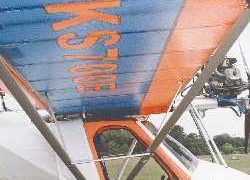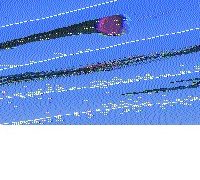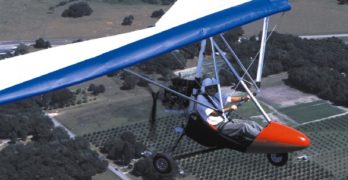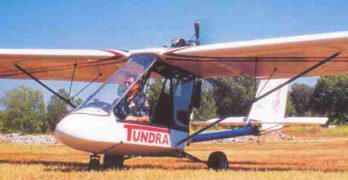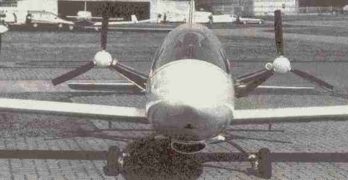The 2000 HKS
In a concerted effort to give Rotax a challenge in the U.S. (and the world), the 60-hp 4-stroke HKS 700E engine arrived in America during 1998. Oh, sure, other engine makers including Hirth, Zenoah, and 2si have been in the market longer but they haven’t made a significant dent in the dominance enjoyed by Rotax.
To be honest, neither has the HKS… yet. Any brand-new engine is bound to have teething pains – even from a company that is a well-established purveyor of engine products in the auto industry. Some of the first 100 HKS engines to arrive in the U.S. experienced various minor troubles.
To the enormous credit of HKS and their American partner, HPower Ltd., all those HKS buyers received the same customer service care that Flightstar buyers have long appreciated. In some cases new parts were sent without charge and in all cases, HKS buyers could count on concerned attention from HPower.
Search Results for : Four stroke and ultralight
Not finding exactly what you expected? Try our advanced search option.
Select a manufacturer to go straight to all our content about that manufacturer.
Select an aircraft model to go straight to all our content about that model.
Convertible Buckeye
In a calculated move planned for over a year, powered parachute leader Buckeye Industries introduced their new trike line at AirVenture ’98. This marks two points of interest to EXPERIMENTER readers.
The first point is a significant entry to the trike market, a segment of ultralight aircraft that has finally shown real growth potential after many years of effort by trike makers. Though European companies threw open the door with persistent marketing efforts mimicked by a few Yankee builders, Buckeye’s entry to the field could increase the number of trikes sold by a good margin.
Secondly, as a widely acknowledged sales leader among powered parachute builders, Buckeye is making something of a statement to that community of aviation enthusiasts. Powered parachutes deserve a follow-on aircraft and Buckeye has decided (logically, to my view) to make that successor a trike.
And, Why Not?
If you owned Buckeye and already made a slick, wheeled carriage for your powered parachutes, wouldn’t you also leverage that design to work for a trike?
The Appeal of Trikes
Trikes: they’re enjoyed around the world by thousands of pilots A what?
Not sure what a “trike” is, are you? Don’t feel bad. Although these machines may represent the largest production of aircraft in the world, many pilots have overlooked their appeal.
A trike is an aircraft made of two principle parts: a wing that resembles a hang glider (but is more stoutly built) and a carriage. The latter element is comprised of an engine, landing gear, seat and instrumentation. Within certain bounds, the wings and carriage can be mixed and matched.
They may sound strange, but they are enjoyed around the world by thousands of pilots. In fact, among European light aviation enthusiasts, about one in every two flies a trike.
Just a toy? Not!
In case you think that such a contraption must be only for young sport enthusiasts that don’t have enough money for a “real” airplane, think again.
Joplin Light Aircraft — Tundra
The Tundra evolved out of experience with the old Beaver 650 that had loads of development but which never really got squarely on the market. Thanks to its resurrection by Laron a few years back, this desirable aircraft flies onward.
Today, the model is built by Joplin Light Aircraft who bought the design rights for the Tundra and 1/2-Tun (single seater). Joplin got started distributing ASAP products in the U.S. but has now grown into an Original Equipment Manufacturer to better implement their own improvement ideas.
One of these upgrades involves the impressive Geo-Suzuki engine. This 65-horse four stroke powerplant burns a mere 2 gph from its smooth-running three cylinders. Best of all the lively engine is priced at $4,995, well below that of some four-stroke options available to ultralight enthusiasts. Joplin makes the Tundra available standard with a Geo-Suzuki conversion, so adding the engine is simpler.
A tandem design, the Tundra is easily appreciated by larger American pilot because it enjoys a wide cabin with ample elbow room.
Rotax’s new 912S
Rotax’s new 912S produces more horses per dollar than its 80-hp 912 (no “S”). One of the big success stories in light aviation powerplants is the Rotax 912. The four-stroke engine evolved from Rotax’s two-stroke line and offered a strong 80 horses. Still, some planes need a little more.
MORE GET UP AND GO
“An airplane that climbs well on the (regular) 912 won’t see much improvement from the 912S,” said one of the leading importers, Phil Lockwood of Lockwood Aviation Supply.
“But if your plane climbs a bit marginally with the 912, the 25% power increase in the 912S will make a world of difference.”
More power usually means more weight; however, the 912S adds a mere 3.5 pounds over the standard 912.
Rotax Aircraft Engines – a division of world aviation leader Bombardier – also offers the 914, a turbocharged version of the 912. The 914 brought power from 80 horses to 115 (with 100 continuous), but comes with a substantial price increase.
Dakota Hawk
Vintage looks. A few companies in aviation specialize in the look and feel of aircraft from yesteryear. These manufacturers offer aircraft that are reminiscent of days gone by in aviation. Visually and even in the way they fly, these machines can transport enthusiasts back to the so-called Golden Era when the nascent aviation industry offered simple, easy to fly aircraft like the Piper Cub and others. Today, most of these specialty aircraft are kit-built airplanes because the freedom of the Experimental 51% rule permits exploration that cannot be justified when making a fully FAA certified model. Some of these kit manufacturers hail from the ultralight community. Fisher Flying Products is one such company.
Second-Generation Fisher
In two ways, North Dakota-based Fisher Flying Products is a second generation company. First, the company now owned by Darlene Jackson and husband Gene Hanson was purchased from Mike Fisher, who subsequently started another business using his name.
FK-11
Let’s check out the FK-11 ultralight.
How would you like to own a Mercedes-brand ultralight? Today you can’t, and maybe you will never be able to, but you may be able to purchase a slick little ultralight called the FK-11 that is well known to Mercedes. And if you want a Mercedes-powered ultralight today, one is being sold.
This month’s “Light Stuff” again ventures across the Atlantic to look at another fascinating aircraft coming from the European sport aircraft community. The pictures accompanying this column feature the FK-11, a prototype design from Otto Funk, lead designer for the German ultralight manufacturer, B&F Technik Vertriebs.
B&F is what Americans might call a family operation. Son Peter Funk runs the business. Otto is his father, who owns an engineering firm and works with Peter as B&F’s design team. Before starting his own enterprise, Otto was an engineer working for Airbus.
Twin-Prop FK-11
The FK-11 is a single-engine ultralight using two aft-mounted props that extend from the fuselage midsection on upward-angled supports.
- « Previous Page
- 1
- …
- 15
- 16
- 17


